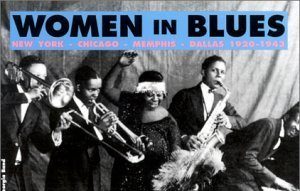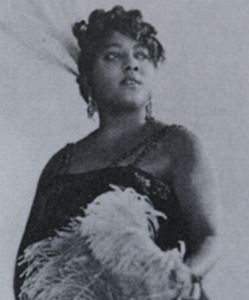Iconic Women of the Blues and their Impact on the Genre

The Blues genre originated in the 1890s in the American Deep South, specifically in the Mississippi Delta. It has since become described by four distinctive characteristics: blues texts (the lyrics), instrumentation, blue notes, and blues form. The blues are also typically sung solo with a singer who plays an instrument or a singer accompanied by a pianist or guitarist. Over the decade, the blues has become one of the most popular genres in the world. Unlike other music genres, where it is harder to find women’s impact, women’s influence within the blues is visible and easily traceable. Female artists’ impact within the blues genre has helped develop the genre to what it is and push it to the forefront of American music.
Mamie Smith

Mamie Smith began her career at the young age of 10, where she started dancing. She would grow to become a dancer, vaudeville singer, and actress that would perform throughout the 30s and 40s. Today, she is best known as the first Black singer to record the blues. In 1920, Smith would record the blues song “Crazy Blues” with Okeh records. This song would become extremely popular, selling 10,000 recordings in the first week and 75,000 in the first month. Due to Smith’s success, more vaudeville blues performers had the opportunity to record blues music during the 1920s. Many of these performers were like Smith, Black women. Due to her successful recording, Mamie Smith and “Crazy Blues” led the way for the growth in popularity of the blues and Black music overall, as well as the Black entertainment industry and the professionalization of Black music. Through Smith’s contributions, the blues genre and Black music as a whole have been able to grow to the great popularity that it has today.
Mamie Smith’s “Crazy Blues”
Ma Rainey - "The Mother of the Blues"

Ma Rainey, born Gertrude Pridgett, has become one of the best-known female blues singers, known as the “mother of the blues.” She was initially a vaudeville singer who later became closely associated with the blues genre. Through her blues performances, Ma Rainey was able to highlight Black stories/experiences and, specifically, her experiences as a Black woman and her bodily autonomy. Ma Rainey was able to help contribute to the evolution of the blues and the growth of the genre’s popularity through her lyrics. which honestly depicted her the Black experience and her experience as a Black woman. During her career, she also mentored another up-and-coming Black woman blues singer, Bessie Smith, who would later be a force in the blues genre herself. Once blues records began to be recorded, Ma Rainey recorded about 92 songs for the Paramount label.
Ma Rainey’s “See See Rider Blues” which was inducted into the Grammy Hall of Fame and added to the National Recording Registry by the National Recording Preservation Board of the Library of Congress.
Bessie Smith - "The Empress of the Blues"

Bessie Smith, or “the empress of the blues,” is known as one of the greatest blues voices. Smith began her professional singing career at the age of 16 when she had the opportunity to tour and perform in different cities throughout the South. During this time, Smith was able to tour in a show with notable blues performer Ma Rainey, who was able to mentor her and help her develop her talent. Like Ma Rainey, Bessie Smith was a vaudeville performer who grew to become closely associated with the blues genre. In her blues performances, Bessie Smith discussed different facets of Black life/the Black experiences, including poverty, racism, sexism, and love. Through these lyrics, working-class Black people were able to relate to her music and help Smith grow in popularity. With her first single, “Downhearted Blues,” recorded in 1923 with Columbia Records, Smith was thrust into stardom, selling hundreds of thousands of copies of her single and later recording 160 songs. Bessie’s smith extreme popularity was able to help popularize the “race records” that were made to market music towards Black audiences. Bessie Smith became a leading figure in the classic blues genre, the highest-paid African American artist in music at the time, and the first African American superstar. Bessie Smith was also able to influence later generations of singers, and her influence on music as a whole can still be seen in the popular music of today.
Bessie Smith’s first single, “Down Hearted Blues”
Sources –
Britannica, The Editors of Encyclopaedia. “Bessie Smith”. Encyclopedia Britannica, 10 Dec. 2020, https://www.britannica.com/biography/Bessie-Smith. Accessed 21 March 2021.
Britannica, The Editors of Encyclopaedia. “Ma Rainey”. Encyclopedia Britannica, 18 Dec. 2020, https://www.britannica.com/biography/Ma-Rainey. Accessed 21 March 2021.
Burnim, Mellonee V., and Portia K. Maultsby. African American Music: an Introduction. Routledge, 2015.
Mahon, Maureen. “How Bessie Smith Influenced A Century Of Popular Music.” NPR, NPR, 5 Aug. 2019, www.npr.org/2019/08/05/747738120/how-bessie-smith-influenced-a-century-of-popular-music#:~:text=With%20her%20subsequent%20recordings%2C%20Smith,the%20earliest%20stars%20of%20recorded.
“Mamie Smith and the Birth of the Blues Market.” NPR, NPR, 11 Nov. 2006, www.npr.org/2006/11/11/6473116/mamie-smith-and-the-birth-of-the-blues-market.
Russonello, Giovanni. “Overlooked No More: Ma Rainey, the ‘Mother of the Blues’.” The New York Times, The New York Times, 12 June 2019, www.nytimes.com/2019/06/12/obituaries/ma-rainey-overlooked.html.
Folk Music Traditions and Neo-Soul Music
Folk Music Traditions and Neo-Soul Music For generations, folk music has been used as a form of expression for African Americans to describe their experiences
The Influence of HBCUs on Spirituals
The Influence of HBCUs on Spirituals What are negro spirituals? Negro spirituals are one of the earliest forms of African American music. It was a
Gender Inequality in Jubilee Quartets
Gender Inequality in Jubilee Quartets Origin The jubilee quartet is a music genre that originated in the mid-1800s as an extension of the American university
R&B and the Evolution of the Vocal Harmony Group
R&B and the Evolution of the Vocal Harmony Group What is R&B? Rhythm and blues, or R&B music, is a form of Black dance music
The Power of Performance: Funk Stage Productions
The Power of Performance: Funk Stage Productions What is funk music? Funk music is a music genre described as an urban form of dance or
Artist Paper – Kehlani
Kehlani “Success to me is only two things: happiness and stability.” Artist History Kehlani Ashley Parrish was born in Oakland, California, on April 24, 1995.

